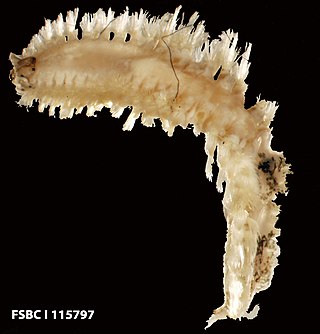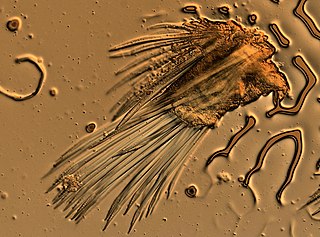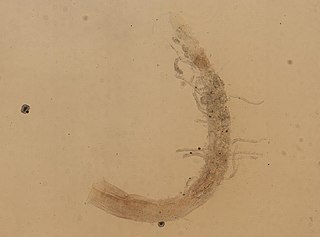
Harmothoe is a genus of marine Polychaete worms belonging to the family Polynoidae. Species of Harmothoe are found world-wide to depths of at least 5,000 m but are more common in shallower water.
Adyte hyalina is a species of marine annelids in the family Polynoidae and the only accepted species in the genus Adyte. Adyte hyalina occurs in the North-east Atlantic Ocean and Mediterranean Sea, at depths down to about 150 metres.

Leucia is a genus of marine polychaete worms belonging to the family Polynoidae, the scaleworms. Leucia contains 2 species, both found in the northern Atlantic Ocean. This genus is distinguished from the closely related genus Harmothoe by having sixteen pairs of elytra, as opposed to fifteen.
Leucia violacea is a species of polychaete worm, commonly known as a "scale worm", in the family Polynoidae. This species occurs in the northeastern Atlantic Ocean.

Acanthicolepis is a genus of marine annelids in the family Polynoidae. The genus was described in 1990 and includes two short-bodied species with up to 50 segments and which occur in the Mediterranean Sea and North-east Atlantic Ocean.
Australaugeneria is a genus of marine annelids in the family Polynoidae. The genus includes 4 species which are commensal on octocorals.
Australonoe willani is a species of marine annelids in the family Polynoidae, and the sole member of the genus Australonoe, known only from the south-east Indian Ocean at Rottnest Island, Western Australia.
Eunoe laetmogonensis is a scale worm known from the north-east Atlantic Ocean at depths of about 800 to 2300 m.

Eunoe nodosa is a scale worm which is widely distributed in the Arctic Ocean, North Atlantic Ocean and North Pacific Ocean from shallow waters to depths of about 1250m.

Eunoe oerstedi is a scale worm which is widely distributed in the Arctic Ocean, North Atlantic Ocean and North Pacific Ocean from shallow waters to depths of about 950m.
Eunoe tuerkayi is a scale worm described from the Mediterranean Sea at depths of about 30m.
Bathynoe is a genus of marine annelids in the family Polynoidae. The genus includes 6 species, 5 of which occur in the Pacific Ocean while one occurs in the Atlantic Ocean. Bathynoe species have been recorded from depths of about 500 – 3000 m.
Austrolaenilla is a genus of marine annelids in the family Polynoidae. The genus includes 10 species which are known from depths of about 20 m to over 5000 m and from the Atlantic Ocean, Southern Ocean and Antarctic Ocean.
Bylgides is a genus of marine annelids in the family Polynoidae. The genus contains 9 species, all found in the Northern Hemisphere and from shallow inshore waters to depths of about 5000 m.
Eucranta is a genus of marine annelids in the family Polynoidae. The genus includes 5 species which are globally distributed from depths of about 40 to 600 m, mostly from high latitudes in the northern and southern hemispheres.
Robertianella is a genus of marine annelids in the family Polynoidae. There are 2 species of Robertianella which are known from depths of about 600 to 3000 m in the north-east Atlantic Ocean and the Mediterranean Sea.
Verrucapelma is a genus of marine annelids in the family Polynoidae. Verrucapelma contains three species which are known from shallow water down to a depth of about 90 m. All three species occur in the Indo-Pacific region, in the Coral Sea, northern Australia and the Indonesian archipelago.
Verrucapelma nigricans is a scale worm known from the South China Sea from intertidal habitats.
Gattyana is a genus of marine annelids in the family Polynoidae. The genus includes 11 species, 9 of which occur in the northern hemisphere, the remaining two are from the Indian Ocean off Mozambique and the Southern Ocean off New Zealand. Species of Gattyana are known from shallow water down to depths of about 1200 m.
Hermadion is a genus of marine polychaete worms belonging to the family Polynoidae, the scaleworms. Hermadion contains a single species, Hermadion magalhaensi which is known from the South Atlantic, South Pacific and southern Indian Oceans at depths to about 110 m.





